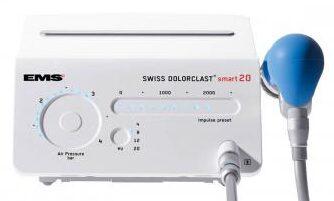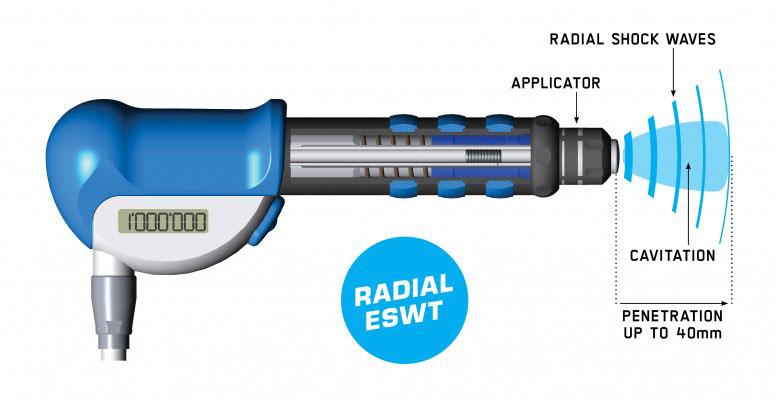Shockwave Therapy
In recent years, shockwave therapy has emerged as a revolutionary non-invasive treatment option for chronic plantar fasciitis or Achilles tendinitis, offering patients an alternative to surgery, steroidal injections and oral medication. Among the cutting-edge devices in this field stands the Swiss DolorClast Smart20 by EMS, renowned for its effectiveness and precision.
To fully benefit from shockwave therapy, a typical course of treatment often consists of three to six sessions, spaced one to two weeks apart.

Interesting Fact: A combination of stretching exercises and custom foot orthotics with shockwave therapy is more effective in treating chronic plantar fasciitis than shockwave therapy alone (Rompe et al., 2015).
How Does Shockwave Therapy Work?
The chiropodist will pinpoint the area(s) that will benefit from Shockwave Therapy
- Comfortable clothing is recommended as you’ll be lying down during the treatment
- Ultrasound gel is applied to the injured area(s), followed by placing the applicator over the skin surface covered in gel
- The Shockwave applicator will then deliver compressed air impulses through the ultrasound gel
- Each treatment typically lasts approximately 15 to 20 minutes.
- A typical course of treatment often involves three to six sessions, spaced one to two weeks apart, to fully benefit from shockwave therapy.
- It’s important to ensure your availability for the full course of your treatment for optimal results
The chiropodist will also provide you with stretching exercises to perform between each session.
Additionally, we may recommend custom foot orthotics to provide support and comfort during daily activities such as walking. These orthotics are tailored to your individual needs and can help alleviate pressure and strain on the affected areas.
What can Shockwave Therapy Treat?
- Achilles Tendon Pain
- Bone Spurs
- Heel Pain
- Morton’s Neuroma
- Tendinitis
- Plantar Fasciitis
Understanding Shockwave Therapy
Shockwave therapy harnesses the power of acoustic waves to stimulate the body’s natural healing processes. By delivering focused energy to targeted areas, shockwaves therapy:
- Promotes the body’s natural healing processes
- Promotes tissue regeneration
- Increases blood flow
- Reduction of pain
- Decreases soft tissue calcifications
- decreases inflammation and swelling
This therapy is particularly effective for conditions such as plantar fasciitis, Achilles tendinopathy, and other musculoskeletal disorders.

Contraindications for Shockwave Therapy
Pregnancy: Generally not recommended for pregnant individuals due to potential risks to the developing fetus. However, the effects of shockwaves on pregnancy have not been thoroughly studied, and caution should be exercised to avoid any potential harm.
Blood Clotting Disorders or taking anticoagulant medications: May be at increased risk of bleeding or bruising following shockwave therapy.
Cancerous Tissues: Shockwave therapy is contraindicated in the area where the treatment is intended.
Open Wounds or Infections: Shockwave therapy should not be applied to open wounds or areas with active infections unless it is cleaned and free from any signs of infection before proceeding with shockwave therapy.
Severe Peripheral Neuropathy: Patients with severe peripheral neuropathy, characterized by significant sensory deficits or impaired nerve function, may not be suitable candidates for shockwave therapy.
Recent Fractures or Surgery: Shockwave therapy should be avoided in areas with recent fractures or surgical incisions that have not fully healed. It is essential to allow adequate time for healing before considering shockwave therapy.
Implanted Devices: i.e. pacemakers, defibrillators, or metal implants near the treatment site, may be at risk of adverse effects from shockwave therapy.
Children and Adolescents: Shockwave therapy is generally not recommended for pediatric patients or adolescents as it may affect the development of the growth plate.
Further Questions about Shockwave Therapy
- The chiropodist will pinpoint the area(s) that will benefit from shockwave therapy.
- Comfortable clothing is recommended as you’ll be lying down during the treatment.
- Ultrasound gel is applied to the injured area(s), followed by placing the applicator over the skin surface covered in gel.
- The shockwave applicator will then deliver compressed air impulses through the ultrasound gel.
- Each treatment typically lasts approximately 15 to 20 minutes.
- A typical course of treatment often involves three to six sessions, spaced one to two weeks apart, to fully benefit from shockwave therapy.
- It’s important to ensure your availability for the full course of your treatment for optimal results.
Shockwave therapy is generally well-tolerated by most patients and is considered to be a relatively comfortable procedure. However, the sensation experienced during treatment can vary from person to person and may depend on factors such as individual pain tolerance, the specific condition being treated, and the intensity settings used.
It’s important to communicate openly during the treatment session as the chiropodist may also adjust the intensity setting or technique to ensure your comfort and minimize any discomfort.
We recommend avoiding strenuous activities or high-impact exercises for the next 48 hours after each session of shockwave therapy. It may be advisable to modify activity levels during this time, depending on your individual tolerance. This precaution can help optimize the healing process and minimize the risk of exacerbating any discomfort or potential side effects associated with the treatment.
You may consider taking a painkiller such as Tylenol or acetaminophen if you experience discomfort following shockwave therapy sessions. However, it’s important to avoid anti-inflammatory medications like aspirin or ibuprofen, as they can potentially interfere with the body’s natural healing process.
Possible side effects of shockwave therapy may include: pain at applicator site, skin redness, skin bruising, nerve irritation with numbness or tingling, and/or swelling.
Ready for your first visit?
Book an appointment today or call us at (416) 444-3668 to learn more about our foot care services.
Rompe, J. D., Furia, J., Cacchio, A., Schmitz, C., & Maffulli, N. (2015). Radial shock wave treatment alone is less efficient than radial shock wave treatment combined with tissue-specific plantar fascia-stretching in patients with chronic plantar heel pain. International journal of surgery (London, England), 24(Pt B), 135–142. https://doi.org/10.1016/j.ijsu.2015.04.082
Tenforde, A. S., Borgstrom, H. E., DeLuca, S., McCormack, M., Singh, M., Hoo, J. S., & Yun, P. H. (2022). Best practices for extracorporeal shockwave therapy in musculoskeletal medicine: Clinical application and training consideration. PM & R : the journal of injury, function, and rehabilitation, 14(5), 611–619.
